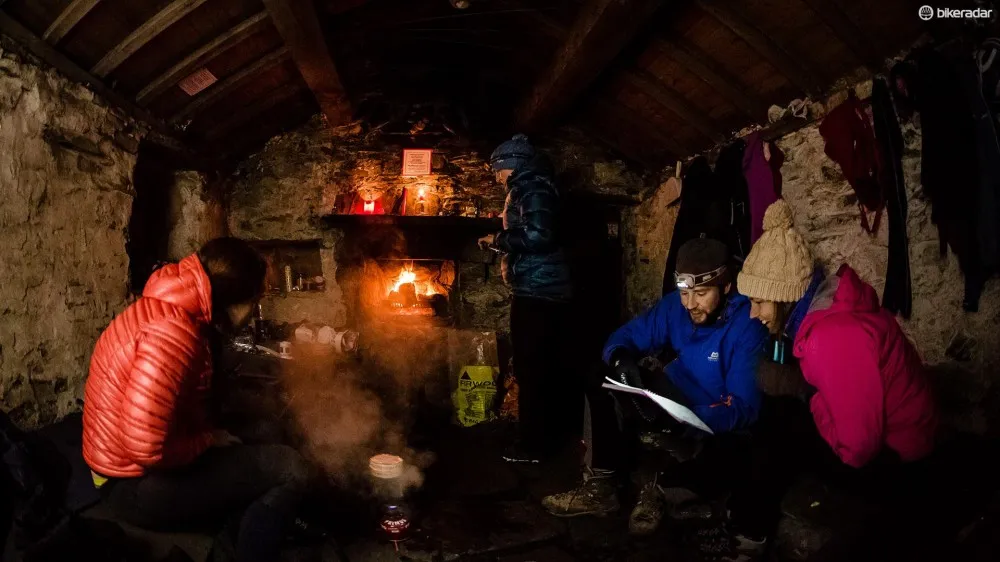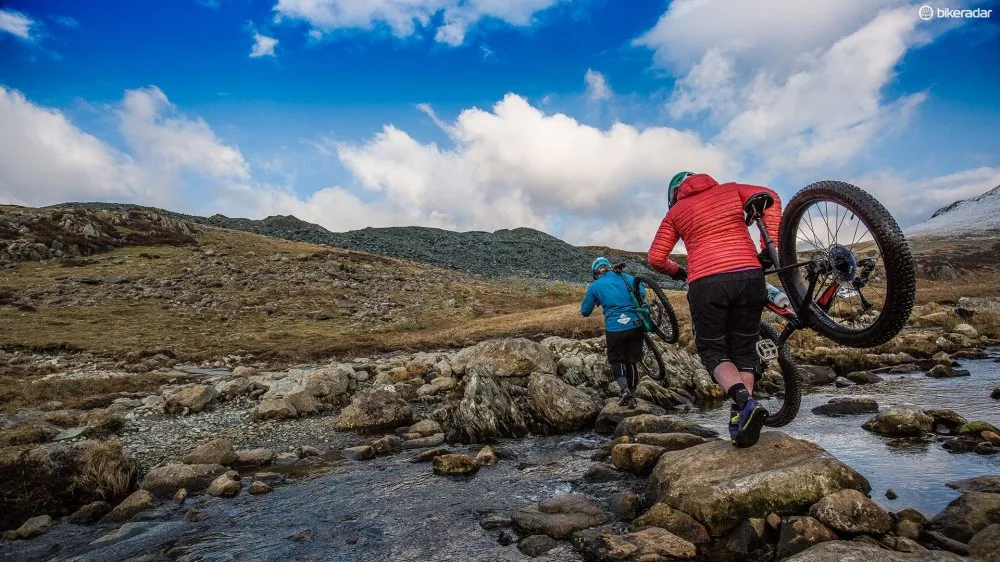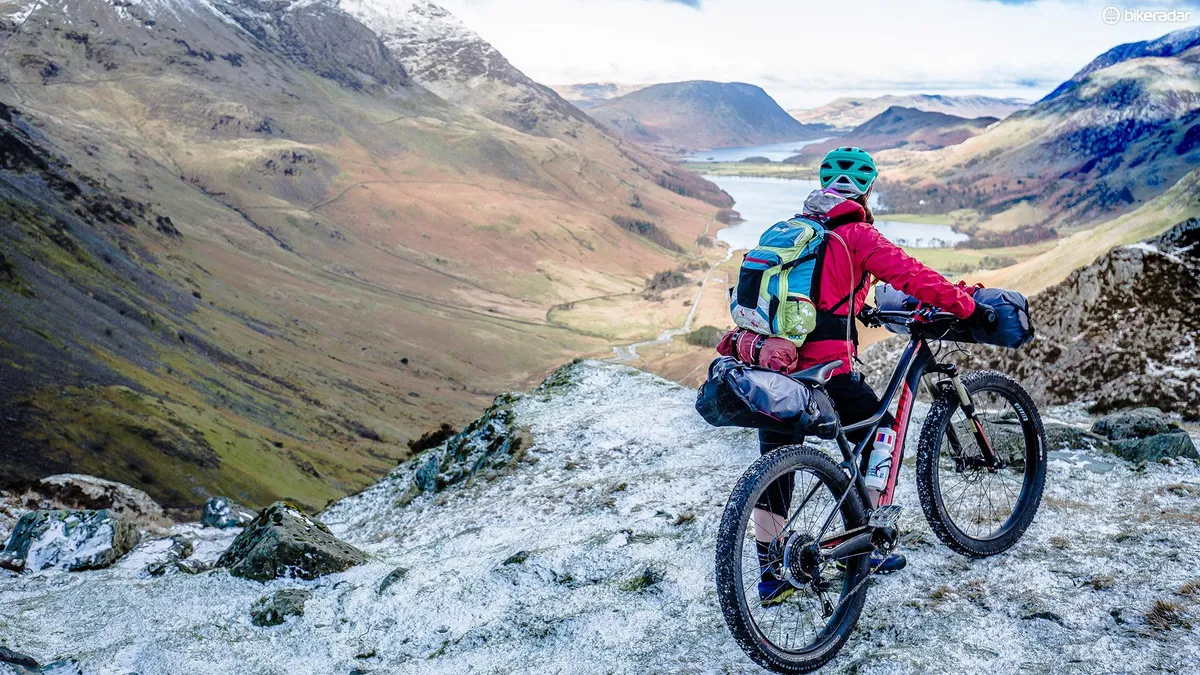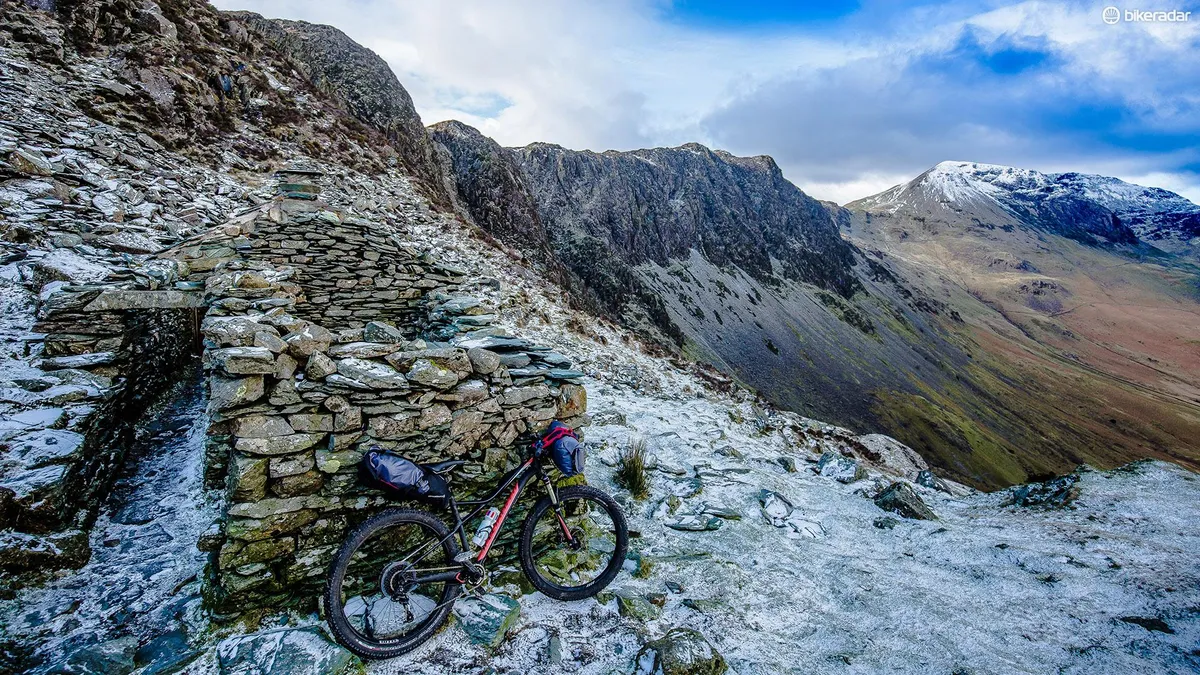Snow-topped mountains, rocky landscapes and glacier-etched valleys with glistening lakes and tarns: England's Lake District is a perfect combination of wild and accessible. It also boasts a wealth of natural trails and bridleways, snaking up high passes and passing through hidden valleys.
If, like me, you like being where no-one else is, then it's the perfect location for a weekend bothy biking adventure.
- The course: Roads, rough bridleways and trails from Keswick to Honister and back, with around 1,200m of climbing.
- The equipment goal: A workhorse MTB that's suitable for loading up with heavy bike bags then riding, climbing and scrambling with it across mountains before pitching up for the night in a tumble-down stone hut for a camp stove feast. And then doing it all again the next day.
- The horse: The Specialized Ruze Comp 6Fattie, a hardtail with 27.5+ wheels, loaded with Blackburn Outpost seat pack and handlebar roll.
Going back to basics
First, for readers unfamiliar with the concept or the term, a little explanation. Bothy biking is simply a form of bikepacking – bothies are basic shelters, usually old buildings, that are left unlocked and open for anyone to use.

That's not a pile of stones – it's a bothy
Most bothies in the British Isles are located in Scotland and Wales, with a cluster – handily for this article – in the mountains of the Lake District. Inside they're pretty basic; some, but not all, will have a fireplace, and if you're lucky there might be a platform to pop your sleeping mat and bag on. Don't expect running water, either.
You can't book bothies in advance, so you may arrive to find others there already. If that's the case, you'll be bunking in together. If the bothy is full, you may need to travel on to the next bothy so it's worth scoping out nearby bothies and leaving time to get to them just in case.
As with any form of bikepacking, all of the necessary kit – such as a stove, fire making materials and plenty of warm clothing – needs to be carried when you bothy-bike.
A visit to the Lake District had been high on my agenda for several months. As far as venues for mini-adventures go, it's got a lot of plus points: reachable from most of the UK in one (long) evening of travelling, plenty of clear paths to follow, but big enough and wild enough to get lost for a couple of days. Also, if you visit at the tail-end of winter as I did, you won't be sharing the mountains with many others. That said, I was very pleased to have veteran bothy biker and experienced mountain bike guide Julia Hobson as my travelling companion and general advisor, guide and imparter of mountain-based wisdom.
My chosen ride was Specialized's Ruze Comp 6Fattie – a women's-specific alloy hardtail plus bike. Normally I like my suspension at both ends of the bike, but for efficiency on the climbs and luggage-carrying capabilities, I decided a hardtail was the way to go, and with mud and loose rock a likelihood, the added traction of a plus-sized tyre was a draw.
The Ruze is Specialized's female-friendly version of the Fuse, and while the head and seat tube angles are the same for each – 67 degrees and 73 degrees respectively – overall the frame is more compact with a significantly lower standover height. There's a lot of standing over the frame with bikepacking, mostly to keep the heavily laden bike in question upright while consulting maps or GPS units, so despite the fact that I'm an above averagely tall woman, I personally found this a welcome tweak.
The reach, head tube length, chainstay length and wheelbase are also shorter on the Ruze compared with the Fuze, along with shorter crank arms, seatpost and lower bottom bracket designed to suit smaller riders.
Loading up and rolling out
With the explosion in popularity of bikepacking has come a proliferation of custom-designed kit, and cycling accessories company Blackburn has recently released its Outpost range of waterproof bike luggage. The system consists of dry bags with packs and rolls to strap them into place on your bike. The handlebar bag also requires a bracket that's relatively easy to fit to your handlebars, so you can lift the whole front pack on and off the bike with a quick turn of the locking system.

Camping stove, a fire and plenty of warm clothing required to fend off the sub-zero temperatures. And all of it needs to be carried when you ride
Keeping things to a minimum is a must when bikepacking. Our essentials included sleeping bags suitable for the sub-zero temperatures we were likely to encounter in the Lakes, bivi bags, lightweight compact sleeping mats, a stove, mugs, torches, a firelog each plus plenty of food and dry clothes for the evening.
Packing all this into the Blackburn bags was fairly painless. Unfortunately the frame bag didn't fit with the dimensions of the Ruze, but the handlebar and seatpost bags, coupled with a carefully packed rucksack, provided ample room. The front roll was spacious enough for the sleeping bag, mat and bivi, with the majority of cooking gear in the rear pack and food and clothing in my rucksack.
Getting an even distribution of weight front and back helps greatly when bikepacking, but even so the first few climbs and descents are likely to be eye-opening as the weight and its location take its toll. I found the front bracket had a tendency to slip down gradually, meaning that quite often the front tyre would end up hitting it when going through rough terrain, or rubbing against it if it slipped low enough. Steering becomes ponderous, as the weight on the bars adds momentum that makes every turn more pronounced. As a consequence, I tried to avoid steering as much as possible as there was no guarantee I'd be able to pull back from a turn if I needed to.
Happily, the Ruze's tractor-like plus-sized tyres will roll over pretty much everything in their path, making short work of rock gardens, rubble-strewn bridleways and sharp, scree-covered slopes. Who needs to pick a line when you can just roll right over the top of the obstacle? It's also stable on rough terrain despite the load and the steering issues, so the overall feel was confidence-inspiring and fun.
A room with a stunning view
After loading up the bags in the carpark at Keswick in the Northern Lakes – note to self: do this the night before next time – we set off along the Borrowdale valley, starting off with a long road climb followed by a few sections of trail, another horrifically steep road climb, and then more off road climbing and pushing. Essentially, day one was all about gaining elevation. The Ruze is a surprisingly light bike for its size, with the alloy frame offsetting the heaviness of the tyres, and blessedly not adding too much to the weight of the camping kit.

Unloaded, the Specialized Ruze Comp 6Fattie made for some fun trail-ragging diversions, making short work of slate-riddled terrain
The wheelset, comprising Specialized Stout XC Pro hubs with WTB Scraper i45 650b+ rims with 45mm width, and set with Specialized 6Fattie Ground Control tyres, felt weighty but sturdy, with little flex detectable under the damping effects of the high-volume tyres. Grip was noticeable on the few wet, rooty sections we rolled through, and the fat rubber made short work of boggy ground. However, the additional weight positioned relatively high up meant any attempt to tilt risked losing traction with the bike skidding out from underneath. This type of riding was all about going smooth, steady and controlled.
The Specialized Stout XC 28t front ring, coupled with the custom SunRace 10-speed 11-40t cassette was ideal for powering up the steep, loose trails you find in the Lakes. However, while I'm used to single-ring setups, I did find getting the loaded bike up some of those climbs an exercise in willpower – albeit nothing that doing a little more hill-riding or carrying a little less trail-snacks wouldn't fix. Ditching the sloe gin was not an option.
The final push to the bothy involved scrambling with the bikes across streams and rocky outcrops on narrow hillside paths. Normally, this would be hike-a-bike territory but with bags attached that was out of the question. Cue much scraping of shins on pedal pins as we pushed and dragged them along the trail.
We reached the bothy in plenty of time to unpack the bikes, lay out our bedding, stock up on water from a nearby stream and head off for a play in a nearby slate quarry before the light faded. The evening meal was cooked on a stove and consumed with red wine from a plastic bottle, while outside the stars shone in patches and a light sprinkling of snow fell. Food and drink always tastes better when it's outside and it's been earned.
Back down to earth
What goes up must come down, and day two involved an endless descent from Honister along the Catbells bridleway and back to Keswick. Repacking the bags (including all our waste) was relatively easy, facilitated by the wide openings on both the Blackburn dry bags.
The descents are where you really notice the traction and, dare I say it, suspension inherent in the tyres. Getting the pressure right is critical with plus, and particularly so when you're planning on carrying a lot of additional weight. Before heading off, I adjusted both the tyre pressure and the SR Suntour Raidon 650+ fork to suit the loaded weight of the bike with me on it.
The Suntour fork only has 100mm of travel, and normally for a Lake District ride I'd consider that far too little. However, first of all I wasn't about to try any fast shredding down singletrack with luggage fore and aft of the bike, and secondly the plus-size treads provide a degree of impact absorption. Coupled with their capable performance over the type of terrain that would normally have me carefully picking a line, this meant the fork's meagre travel was more than enough, even when it came to successfully negotiating some not insignificant drops and rock gardens.
Stopping distance was another element of the ride where the presence of heavy luggage had to be carefully factored in. While the TRP Slate X2 hydraulic disc brakes performed admirably, remaining powerful with impressive modulation for subtle control, I was horribly aware that any attempt to brake suddenly would probably result in the bike flipping sideways and taking me with it, so slow, steady and controlled braking was a necessary skill.

Point the bike straight down and roll, baby, roll!
Verdict: mostly plus
Big tyres give great traction when rolling down loose, wet scree-covered slopes, a particular boon when your bike is laden down with fully loaded bags. They also smoothed out the roughest terrain, allowing straighter line choice and a more forgiving ride which was crucial given how the addition of luggage affected the agility and handling of the bike.
The lack of rear suspension wasn't felt as keenly as expected, as the large volume tyres provided a significant amount of cushioning, albeit in a slightly bouncy way. The tyre volume does mean that as much attention needs to be paid to tyre pressure as it does to suspension setup to deal with the additional weight of camping kit, food and spares. Get it right, and you've got a confidence inspiring and efficient ride that opens up the mountains to multi-day adventures.
Julia Hobson's top bikepacking tips
- Bring plastic bags or shoe covers for keeping your feet dry in wet bike shoes when you're in the bothy. It saves bringing a spare pair of shoes!
- Use boxed wine (without the box) or decant into a plastic bottle so you don't have to carry glass in and out.
- Bring squeezy condensed milk! It means you don't need powdered milk (yuck) or risk spilling normal milk in your bag.
- Use fuel logs or similar for your fire. They're easy to transport, lighter than bag of wood or coal and burn for ages.
- If you're using a handlebar bag, don't put heavy stuff in there or the riding won't be fun! Use frame packs or carry stuff on your back. If you pack light you will only need around a 30l rucksack (with some stuff attached to sides).
- Specialized Ruze Comp 6Fattie £1,400 / $1,600 / AU$2199 (on sale to $1499 on Specialized Australia website)





